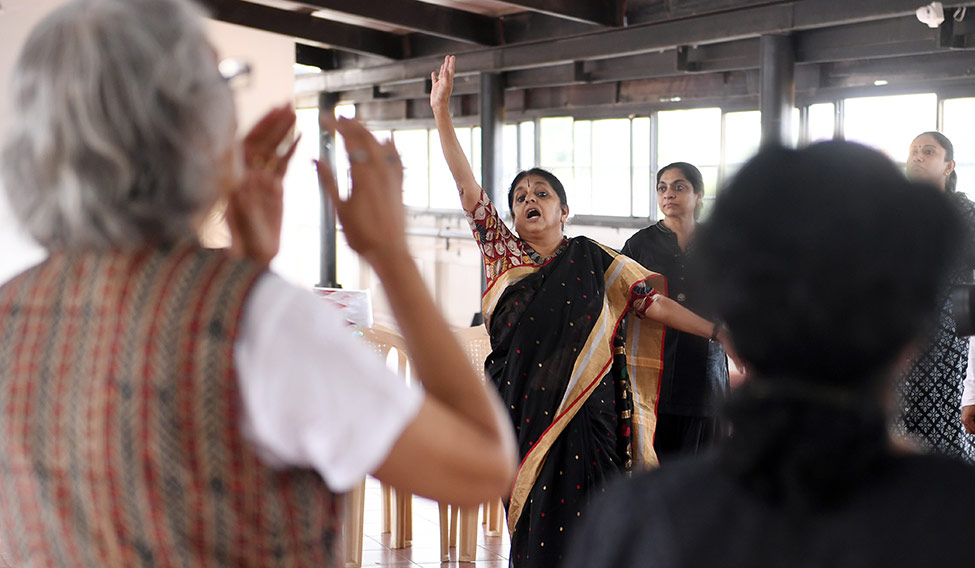It is a usual balmy Bengaluru day in September. But on the topmost floor of The Brigade School in JP Nagar an unusual class is about to start. The ‘students’ are the school’s teachers and principal. Their teacher for the day is the internationally renowned storyteller Geeta Ramanujam. Wearing a microphone, she goes about evaluating the art assignment she gave them in the previous session. “Am I loud enough?” she asks, to a round of immediate nods. “So, do you remember the fable of the crow and the pitcher? Once, a crow was very thirsty. [Makes parched sounds.] He found a jug of water but could not reach in for a drink. He looked around and saw pebbles. One by one he dropped them into the jug and the water level rose. As that happened, he was able to drink the water…. Now imagine if he kept dropping the pebbles, the water level rose beyond the jug, spilled out and more crows gathered around? [Makes sounds of several crows cawing.] Would we perhaps say, oh those are the Kannadiga crows and those are the Tamil crows?” Ramanujam says with a twinkle in her eye, linking an age-old fable to the recent crisis that held the city hostage. The room erupts in laughter. The 60-year-old educator with nearly four decades of experience in the field has made her point.
A decade ago Ramanujam established Kathalaya, a first-of-its-kind academy of storytelling in India, and it now has a centre each in Ireland and Colombia and affiliations with the International Storytelling Center, Tennessee, USA, the Scottish Storytelling Centre, UK, and the University of Skövde, Sweden. She wants to infuse a new energy in Indian classrooms by bringing back the forgotten culture of storytelling. To date, she has trained more than 70,000 people across 23 countries. “In my years of experience with education, I felt the interest between a teacher and child was lessening. It led me to wonder, what is learning all about? Is it gathering information or application? Where and how does one drop the seed? So we started the academy that has grown several trees over the years [referring to storytellers] who have now become the shade for other trees,” she says. Ramanujam’s institute coined the phrase ‘story entrepreneurs’ to define people who are formally trained and can set up their own storytelling outfits. Storytelling is slowly being seen as a viable career option. “A storyteller we trained in Hyderabad recently is earning Rs 30,000 a month, working thrice a week,” she says.
Personally, Ramanjunan has a “bag of stories”, mostly Indian tales, that are “turned, twisted, adapted” according to her listeners. “I can tell the same story to kids and adults, making a number of sound and animal effects or using props for the kids. If I am narrating the ‘dewdrop and flower’ story, children enjoy the added effects of, say, water [makes a spontaneous plop plop sound], while adults want the philosophical take on it, which is that a dewdrop who wants to be like the flower must learn to be more accepting of itself.” She uses puppets for children with special needs.
Over the years, her work has received patronage from organisations such as the Azim Premji University, rural schools in Karnataka and marketing and medical professionals across the country. “When a child is born, he or she sees visuals first. A baby relates to pictures, not words,” she says. “The reason why storytelling is surviving is that it is so powerful. We all relate to sounds. But there is no oral recall—that helps build memory and language skills—in schools today. Personally, I don’t encourage competitiveness by telling children, ‘You are the best or the worst’. When I tell the hare and tortoise story, they both finish the race together. I want to eventually create a chest of stories which would have a pedagogical flow for all age groups.” Ramanujam grew up in an era without gadgets and listened to her parents telling stories every night. “My father told stories in English, mother in Tamil, which also helped strengthen both languages for me.”
What does she make of the situation in other countries? “Eastern countries are more animated in their telling. Some western countries use music to assist storytelling. Europeans and Brazilians are emotional listeners. But, in Scotland, you see no reactions. Initially that bothered me because as a storyteller, seeing audience reaction and expression is key, but later I learned that they listen and absorb it at deeper levels.”
As someone who speaks seven languages, grew up in three Indian metros, what is this storyteller’s favourite story? “The mountain and the bird,” she says, later at the academy. “It can also be used in a maths class to explain dimensions and angles. There was once a mountain who lived all alone watching seasons change, till one day a bird came and sat on his shoulder. She told him all about her travels, where she had been, what all she had seen and eaten.... The mountain felt wonderful having this new friend in his life. Soon it was time for her to join her flock and leave him, but the bird promised the mountain she would return with more stories, and she did. Every year. Theirs grew into a wonderful friendship.... As a storyteller, I am sometimes the mountain, silent and still, sometimes the bird, chirpy and talkative.”
TELL TO TEACH
Storytelling is considered to be the oldest form of teaching. It perhaps even led to the evolution of language. Human brains are wired to think in terms of a beginning, middle and end to understand the world around them. It improves listening skills and enthusiasm levels, and inspires writing. UNESCO recognises storytelling as a valuable educational resource.








